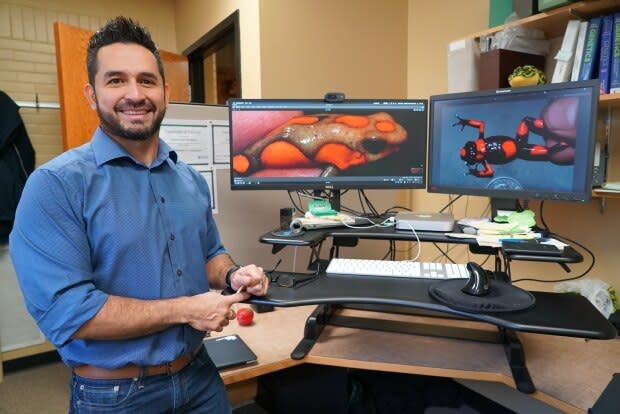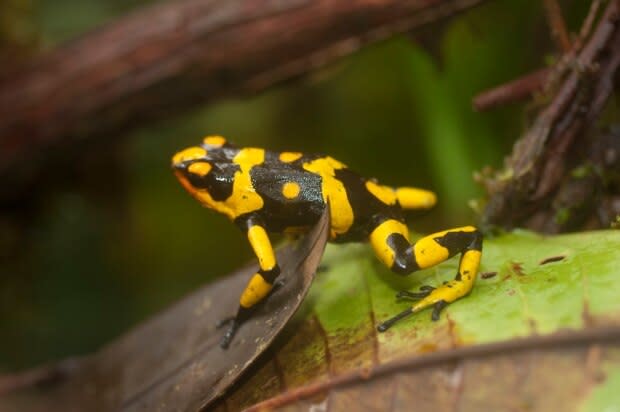Sask. researcher says discovery will help protect colourful, poison frogs
A Saskatchewan-based researcher who left the ice-cold Prairies for humid Colombian jungles in search of vividly hued harlequin frogs says his latest discovery about the endangered amphibians gives them a better chance at survival.
In 2018, University of Saskatchewan biologist Andrés Posso-Terranova described three new species of harlequin poison frogs that were previously classified as a single species. One of them, Oophaga andresi, is named after him.
Now Posso-Terranova has discovered that hybrid frogs, which show mixes of colour and pattern from different species, exist due to naturally occurring interbreeding.
Originally it was thought the hybrids might be the result of human interference linked to trafficking of the frogs on the international black market.
Posso-Terranova had heard from people in Colombia that some frogs had been moved from deep in the jungle to areas closer to homes for easy access to sell to traffickers.
"We performed genomics analysis and then we discovered that these individuals are … not recent hybrids," he said, adding that this finding suggests they hybridized naturally, because it occurred more than 20 years ago.
The study, which was recently published in the journal Molecular Ecology, shows the hybrid frogs are the result of interbreeding between the Oophaga anchicayensis and the critically endangered Oophaga lehmanni.

Posso-Terranova said the hybrid may eventually be defined as its own species, depending on further genetic analysis.
For now, he said, the discovery helps illustrate that the hybrids should be protected and allays any concerns that they could pose a genetic threat to existing "pure" species.
He said identifying and naming individual poison frog species is key to their survival long-term.
Posso-Terranova started researching the genetic diversity of the poison frogs because, having grown up near the Chocó tropical rainforest, he saw how quickly their populations were dwindling.
One researcher had previously classified the harlequin frogs, known to scientists as Oophaga histrionica, as being one species in research dating back to 1967.
But there was a huge amount of diversity in the splashes of colour and patterns displayed by the frogs as a warning to predators.
"If you propose that you have a particular group of frogs that are all over the place and it's only one species you may think, 'Oh, this is very common," he said.

After discovering the new species in 2018, Posso-Terranova decided to focus his research on the hybrids.
He said these types of discoveries are needed to promote conservation because threats to the endangered harlequin frogs are serious and wide-ranging.
He said wildlife traffickers exploit impoverished Colombian people by paying them a few Canadian dollars to collect hundreds of poison frogs, which can fetch prices of up to $2,000 on the international black market.
Posso-Terranova said government conservation policies alone cannot protect the frogs.
"I completely believe that in order to conserve this species you have to have the participation of the people living there," he said.

Columbian universities are now providing funding for local people to develop ecotourism as an alternative source of income that discourages illegal trafficking, he added.
There are also efforts to encourage the government to purchase land where there is important frog habitat.
As a specialist in genetics, Posso-Terranova brings his knowledge and experience back to Saskatchewan to share with students in Saskatoon.
He is an instructor and lab co-ordinator at the University of Saskatchewan, where his desk is surrounded by toy frogs and frog paintings drawn by school children he has presented to.
Posso-Terranova said hiking the Colombian jungles for the vulnerable creatures can be draining — until he finds them.
"When you find the frogs, when you work for them, when you realize you are doing something good for them, you feel good," he said.

